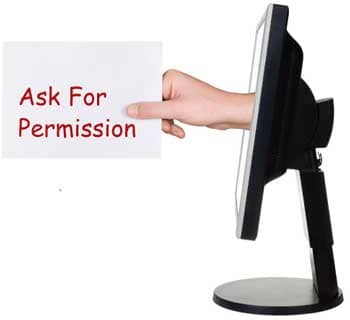Four tips to strengthen customer relationships.
Operations by David McMahon
There is a shift that is occurring in the advertising world. Resources from newspaper, yellow pages, TV, cable, and radio advertising are being reallocated to web sites, internet search, email media, and mobile media. This change has just started to occur in the furniture industry. New media is uncharted territory for many furniture retailers, but with a bit of knowledge you can be one of the first in our industry to do it right.
The big guys such as Rooms to Go, IKEA, Thomasville, Ethan Allen, Nebraska Furniture Mart and many independents are aggressively collecting and using customer and prospect email addresses to help build customer loyalty and keep their best customers from shopping in other places (like your store).

Some of these companies collect email addresses from shoppers, buyers and on the internet and then they follow-up with various levels of customer contact. Most send a general monthly or semi-monthly email promotion that is totally advertising focused. This is a start, and it is easy to do.
A few provide value driven content-based e-marketing newsletters targeted to their customer’s interests. This is even better then emailing a promotional message because it provides value to current customers/prospects and helps to build long term relationships.
I define e-Marketing as permission- based marketing and follow up done through interactive media such as the internet. It can be done through web pages, search engine optimization (SEO), mobile short message services (SMS), or email. In this article we will largely focus on using email.
Even as e-Marketing is on the rise, most independent furniture retailers hang on desperately to old guard marketing. They see change as a risk, and decide to stick with what and whom they know. Traditional media has worked in the past for them and they hope that their customers will come back. They hope that just by changing the mix of traditional media, buying smarter and tweaking the message, they will attract more business. To a degree, this strategy can work, especially with retailers that have made poor media buys, neglected to quantify results, and run tired advertising that fails to differentiate their store brand or motivate customers
Those of you who have been following Leslie Carother’s excellent FURNITURE WORLD Magazine series that covers e-marketing and social networking (posted to the furninfo.com article archives) have seen that there is an opportunity to connect with customers in a substantial way at low cost by using new media. Furthermore, it can be done in a way that other retailers in your market probably haven’t even considered.
New media enables independents to compete on a similar playing ground locally as a national or regional powerhouse! It is far less costly than traditional media as it is driven by brains, creativity, and knowledge of the virtual world. You may not be able to match Ashley Furniture’s newspaper insert budget, but you can connect with customers and give them targeted information that supports your brand, boosts retail traffic and sales.
Consider these points:
- Most stores get the majority of their sales from within a 30 mile radius of where their customers live or own a property.
- There are usually several shopping choices in that 30 mile area.
- The majority of your store sales come from the top 20% of customers.
- Your top customers are also someone else’s top customers.
- Many of your younger customers and virtually all of your future customers demand Modern Media – they grew up with it.
This is your window of opportunity. You will eventually need to embrace modern media, so why not do it before your competition? Change is hard, but playing catch-up is harder. Trying to come from behind has put the nail in many coffins.
4 tips To harness the power of e-Marketing
1. Always Provide Value And Build Relationships: So, the population is not growing that fast. Your baby boomer customers are retiring and have a fixed income. Your best customer’s sons and daughters grew up with the internet and email. But, these new buyers are getting married and will be looking to furnish their own homes.
The key is to communicate in a new fashion to these baby boomers and their tech demanding children. They expect you to be a savvy marketer so that they can:
- Find you on the internet easily.
- Give them a website experience that provides answers all their questions, has a modern look and excellent functionality.
- Receive relevant information when you contact them.
If you don’t live up to these expectations, they won’t hesitate to give their business to those that do, such as IKEA and Crate and Barrel.
Contact with your old and new customers should be geared toward value. Examples include, contact for past purchase, special order update, delivery confirmation, preferred customer events, e-Newsletters, and specific next purchase ideas. They do not want spam!
The new consumer does not get the newspaper, digitally records television shows, opts out of mailed catalogs on www.catalogchoice.org, never looks at the yellow pages and has only one phone – an internet capable mobile phone.
Consumers now give permission to only those companies they like and respect.

2. Ask for Permission: New media is about permission. Consumers have gotten hit over the head for years with interruptive marketing practices. Their TV shows are put off by loud yelling car or furniture commercials, the paper is jammed with garbage that was once trees, and their mailbox overflows with junk if not checked each day. If you say, “Well, interruptive advertising has worked for me”, I say, “Nothing lasts forever.”
Consider permission. Now, people have choice – On Demand. They can avoid commercials with TiVo, digi cable and satellite. Many aren’t renewing their newspaper subscriptions, instead looking for free news online. They are also being proactive about opting in to email messages and newsletters they want to receive, and out of unwanted email offers.
Do not send unsolicited e-Marketing as it will end up in your customers spam filters or worse yet, get reported as spam and your company will end up on an email blacklist. Businesses must by law provide opt out options. Proper businesses only send emails if the customer grants permission. There is no opt-out with old-guard media.
Asking permission isn’t difficult. There are many ways to get customer emails online, through entry forms, give-aways (such as a free decorating guide or chance to win merchandise) or in the store at the point of contact using a simple dialogue such as this:
“Would you like to sign up as a preferred customer, for free? We will keep you informed on any orders. And, you will get our exclusive email home style newsletter. Of course you will get exclusive notice of events not open to general public”
Some of you may say, “Most are going to say no!” Well, that may or may not be true. What is true is that some will say yes and over time you will create a gold mine. One client of mine reported 9 out of 10 email addresses were being obtained from his customers, and that he no longer does any newspaper marketing.
The next thing I hear from the mouths of skeptics is, “Well, I don’t have many email addresses, so it’s not worth it!”
Well, that’s the old-guard in them talking. The ideal email audience is an audience of “one”. That is because email can be totally personalized and targeted. It is actually easier to start a program with fewer emails because you can be sure that email addresses will be collected properly. The key to success with e-Marketing is to have smaller targeted message batches.
A general formula that quantifies this relationship between successful e-Marketing and the elements that go into creating an email message is:
Degree of Refined Database Segmentation
+ Relevance of Campaign To the Target Consumer
= Level of Response.
A permission based smaller list that is targeted will have much better results than a larger list that was obtained through questionable means. But don’t worry if your list is sub par. There are ways that stores and salespeople can build great lists quickly. It usually takes only one targeted campaign to pay for a years worth of email media advertising.
Permission marketing does not only include email of course. There is also web media. With web media, you can drive traffic to your web site by allocating a certain amount of your ad budget per month to target web searches in a defined area close to your stores. Through geo-tracking, advertisers such as Google will list your site by search term. Google “knows” where your store is through your computer’s IP address and can direct your advertising efficiently to those consumers who are most likely to buy from you.
3. Introduce new media partners: Unfortunately, media reps and some old friends you’ve purchased traditional media from are seldom equipped to move your company into the future. They generally get paid based on how much media you buy, not on how well it performs. e-Marketing companies are fresh. Typically they employ forward-looking people who are marketing, database and tech wise. They have new ideas and are results oriented. e-Marketing results are known immediately. This has the advantage of allowing savvy marketers to make mid-course corrections to work toward improved results.
Here is one example of a forward-looking marketing campaign implemented by a home furnishings retailer (Let’s call it XYZ Furniture). Through a custom database query, XYZ Furniture segmented its customer database to identify outside designers. XYZ then created an email tailored to the specific needs of this group. The result was that 90% of the outside designers saw the campaign, and 40% of them purchased.
I’m not saying get rid of all the old. I am saying that it is time to transfer advertising dollars to new media partners that understand furniture operations, how to craft creative e-Marketing messages, how to build a useful customer/prospect database, and how to integrate data, messages and vehicles (including traditional media) into intelligent and result-oriented programs. For more information on this topic, read Leslie Carothers’ excellent FURNITURE WORLD series. Past articles are posted to the marketing management archives on the furninfo.com website.
4. Re-allocate resources: So, how much money should you allocate to your new partners? Some other industries are spending 10% or more on e-Marketing, but there aren’t any “rules of thumb” for our industry. What matters is that you start in the right way and that you get results.
If you are starting from scratch because you need to redevelop your website, depending on your needs, there are decent options from $300 to $5,000 per month. If you want to have search engines bring your listings towards the top of searches in an average trading area, expect to invest another $1,500 per month. Add to this some advanced and integrated database email marketing so you can make segmented queries, and you will probably invest an additional $1,500 in systems and very little per month. And finally, to make sure that you do it right the first time, professional training and consulting firms may charge between $1,500 and $2,000 per day.
All these costs are minimal when you consider the overall ad budget size of most furniture retailers and the huge opportunity cost of ignoring new media or just setting up an average website and sending out occasional bulk emails.
NEXT ISSUE
Details on how to effectively manage your database to produce results. How to execute targeted campaigns, and how to track results.
Until then, explore your options for new media partners!
David McMahon is Director of e-Commerce and business coach for PROFITconsulting. PROFITconsulting is a full service consultancy and marketing agency that specializes in retail furniture. FURNITURE WORLD readers can contact David at david@furninfo.com. For more information on this topic, go to www.furninfo.com to read all of David McMahon’s articles.